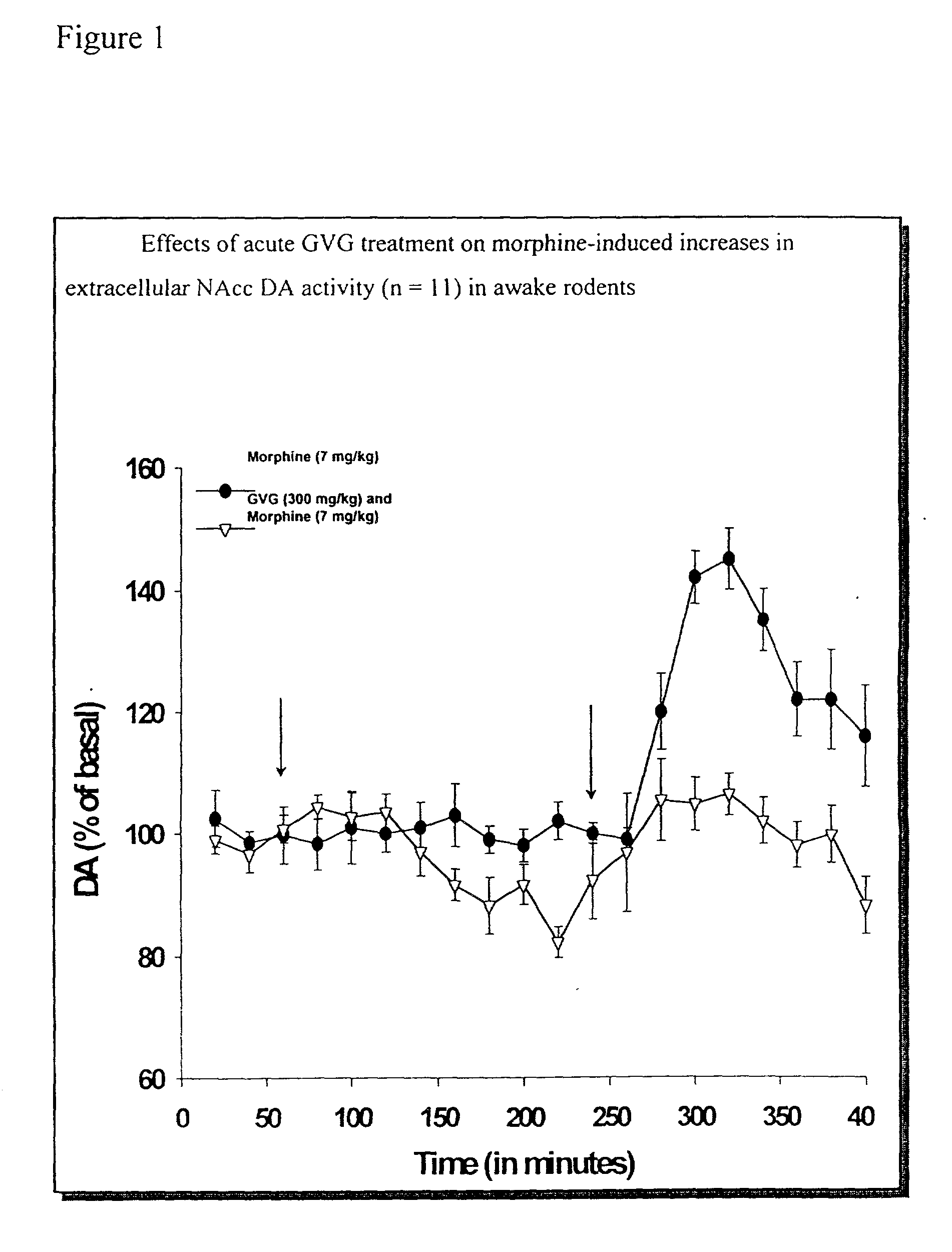Prevention of addiction in pain management
a technology for pain management and addiction, applied in the field of composition for treating pain in mammals, can solve the problems of inability to quantify the adequacy of pain control regimens, poor treatment, and one of the most troubling and difficult areas of medicine, and achieve the effect of reducing the concentration of da in the na
- Summary
- Abstract
- Description
- Claims
- Application Information
AI Technical Summary
Benefits of technology
Problems solved by technology
Method used
Image
Examples
example 1
[0074] The effects of increased endogenous GABA activity on morphine-induced extracellular DA concentrations in the nucleus accumbens (NAcc) of freely moving rats was explored.
[0075] All animals there used under an IACUC-approved protocol and with strict adherence to the NIH guidelines. Adult male Sprague-Dawley rats (200-300 g, Taconic Farms), housed in the animals care facility under 12:12 light / dark conditions, were placed into 6 groups (n=3-6), anesthetized and siliconized guide cannulae were stereotactically implanted into the right NAcc (2.0 mm anterior and 1.0 mm lateral to bregms, and 7.0 mm ventral to the cortical surface) and prefrontal cortex (PFC) at least 4 days prior to study. Microdialysis probes (2.0 mm, Bioanalytical Systems, BAS, West Lafayette. Ind.) were positioned within the guide cannulae and artificial cerebrospinal fluid (ACSF. 155.0 mM NA.sup.-, 1.1 mM Ca.sup.2-, 2.9 mM K.sup.-. 132.76 mM Cl.sup.-, and 0.83 mM Mg.sup.2-) was administered through the probe us...
example 2
[0079] The effect of GVG on the analgesic potency of morphine in male Sprague-Dawley rats was examined using the hot plate test. In this paradigm, animals are treated and placed on a hot plate at a temperature of 53 degrees Centigrade and the latency to licking of one of the forepaws was measured. This test is used as screen for agents that have moderate to significant analgesic action as these drugs will increase latency to forepaw licking.
[0080] The rats were treated with either vehicle or GVG 2.5 hours prior to receiving either vehicle or morphine. Animals were given either vehicle or morphine 30 minutes prior to placing them on a hot plate at a constant temperature of 53 degrees Centigrade. Analgesic potency was assessed by measuring the latency to forepaw licking after placement on the hot plate. A total of 10 rats were examined for each treatment group. Each value represents the latency in seconds to forepaw licking +S.E.M. The results are set forth in Table 1.
1 TABLE 1 Pretre...
example 3
[0082] Heroin-induced conditioned place preference was then examined. Heroin is an effective analgesic, similar to morphine.
[0083] In all rodent studies, male Sprague-Dawley rats were used (200-225 g. Taconic farms, Germantown, N.Y.). Animals were allowed to acclimate to the animal housing facility for at least 5 days prior to beginning the experiments. Conditioned place preference (CPP) chambers were used as previously described (Lepore et al., 1995), except instead of one chamber being entirely white and the other black, one chamber was entirely light blue with a stainless steel floor and the second chamber was light blue with horizontal black stripes (2.5 cm wide) spaced 3.8 cm apart with a smooth plexiglass floor. In all CPP studies with GVG, the saline volume was (1 ml / kg), and the heroin doses were 1.5 mg / kg. The saline, heroin and GVG were all injected intraperitonealy (i.p.). The conditioning procedure for the acquisition phase consisted of 12 sessions carried out consecutiv...
PUM
| Property | Measurement | Unit |
|---|---|---|
| flow rate | aaaaa | aaaaa |
| flow rate | aaaaa | aaaaa |
| temperature | aaaaa | aaaaa |
Abstract
Description
Claims
Application Information
 Login to View More
Login to View More - R&D
- Intellectual Property
- Life Sciences
- Materials
- Tech Scout
- Unparalleled Data Quality
- Higher Quality Content
- 60% Fewer Hallucinations
Browse by: Latest US Patents, China's latest patents, Technical Efficacy Thesaurus, Application Domain, Technology Topic, Popular Technical Reports.
© 2025 PatSnap. All rights reserved.Legal|Privacy policy|Modern Slavery Act Transparency Statement|Sitemap|About US| Contact US: help@patsnap.com

